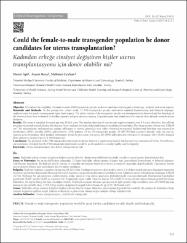| dc.contributor.author | Api, Murat | |
| dc.contributor.author | Boza, Ayşen | |
| dc.contributor.author | Ceyhan, Mehmet | |
| dc.date.accessioned | 10.07.201910:49:13 | |
| dc.date.accessioned | 2019-07-10T20:03:56Z | |
| dc.date.available | 10.07.201910:49:13 | |
| dc.date.available | 2019-07-10T20:03:56Z | |
| dc.date.issued | 2017 | en_US |
| dc.identifier.citation | Api, M., Boza, A., ve Ceyhan, M. (2017). Could the female-to-male transgender population be donor candidates for uterus transplantation? Turkish Journal of Obstetrics and Gynecology, 14(4), 233-237. https://dx.doi.org/10.4274/tjod.55453 | en_US |
| dc.identifier.issn | 2149-9322 | |
| dc.identifier.issn | 2149-9330 | |
| dc.identifier.uri | https://dx.doi.org/10.4274/tjod.55453 | |
| dc.identifier.uri | https://hdl.handle.net/20.500.12511/3968 | |
| dc.description | WOS: 000424218200009 | en_US |
| dc.description | PubMed ID: 29379666 | en_US |
| dc.description.abstract | Objective: To evaluate the eligibility of female-to-male (FtM) transgender people as donor candidates with regard to histologic, surgical, and social aspects. Materials and Methods: In this prospective cohort study, 31 FtM transgender people underwent standard hysterectomy and bilateral salpingo-oophorectomy for gender reassignment upon their request. The pelvic viscera of the transgender people was intraoperatively observed and the histology of the removed uteri were evaluated for fertility capacity and procurement surgery. A questionnaire was administered to explore their attitude towards uterus donation. Results: The mean +/- standard deviation age was 28.5 +/- 5 years. The median duration of testosterone supplementation was 2.4 years; therefore, they all had irregular menstrual periods during this therapy. None had any previous abdominal surgery or additional morbidity. The mean uterine volume was 138 +/- 48 cm(3). No adenomyosis, endometriosis, polyps, adhesions or uterine anomalies were either observed or reported. Endometrial histology was reported as proliferative (58%), atrophic (29%), and secretory (13%) pattern. Of the 31 transgender people, 30 (96.7%) had a positive attitude; only one had no opinion at the beginning. After detailed information about the procedure was given, 26 (84%) still wanted to volunteer for donation, but 4 (12%) changed their opinion to negative (p=0.12, McNemar test). Conclusion: The proposal of the FtM transgender population as uterus donor is a hypothetical model that has not been experienced before. Nevertheless, our experience revealed that the FtM transgender population would be good candidates socially, legally, and biologically. | en_US |
| dc.description.abstract | Amaç: Kadından erkeğe cinsiyet değiştiren kişilerin uterus donörü olmaya uygunluklarını histolojik, cerrahi ve sosyal açıdan değerlendirmektir. Gereç ve Yöntemler: Bu prospektif kohort çalışmada, 31 kişiye kadından erkeğe cinsiyet değişimi için laparoskopik histerektomi ve bilateral salpingoooferektomi uygulandı. Bu kişilerin pelvik viserası ve çıkarılan uterusların histolojileri üreme potansiyeli açısından değerlendirildi. Operasyon sonrası uterus donörü olmaya dair tutumlarına dair bir anket uygulandı. Bulgular: Kişilerin ortalama ± standart sapma yaşı 28,5±5 yıldır. Ortalama testosteron desteği alma süresi 2,4 yıl iken destek süresince hastaların tümünün menstrüel periyotları düzensizdi. Herhangi bir kronik hastalık veya geçirilmiş abdominal cerrahileri yoktu. Çıkarılan uterus volümlerinin ortalaması 138±48 cm3’tür. Herhangi bir adenomyozis, endometriozis, polip, adezyon veya uterus anomalisi gözlemlenmedi veya raporlanmadı. Endometrial histolojileri proliferatif (%58), atrofik (%29) ve sekretuar (%13) paternde rapor edildi. Otuz bir kişinin 30’u (%96,7) uterus donörü olma yönünde pozitif bir tutum bildirirken, bir kişi herhangi bir fikri olmadığını söyledi. Nakil için uterusun alınması operasyonu ile ilgili ayrıntılı bilgi verildikten sonra 26 (%84) kişi hala donasyon için gönüllü iken, 4 (%12) kişi kararını değiştirerek negatif tutum beyan etti (p=0,12, McNemar testi). Sonuç: Kadından erkeğe cinsiyet değiştiren kişilerin uterus donörü olması daha önce denenmemiş hipotetik bir modeldir. Bu çalışma ile kadından erkeğe cinsiyet değiştiren kişilerin sosyal, hukuki ve biyolojik açıdan donör olmaya uygun adaylar olduğu düşünülebilir. | en_US |
| dc.language.iso | eng | en_US |
| dc.publisher | Galenos Yayıncılık | en_US |
| dc.rights | info:eu-repo/semantics/openAccess | en_US |
| dc.subject | Uterus | en_US |
| dc.subject | Transplantation | en_US |
| dc.subject | Live Donor | en_US |
| dc.subject | Transgender People | en_US |
| dc.subject | Uterus | en_US |
| dc.subject | Transplantasyon | en_US |
| dc.subject | Canlı Donör | en_US |
| dc.subject | Transgender | en_US |
| dc.title | Could the female-to-male transgender population be donor candidates for uterus transplantation? | en_US |
| dc.title.alternative | Kadından erkeğe cinsiyet değiştiren kişiler uterus transplantasyonu için donör olabilir mi? | en_US |
| dc.type | article | en_US |
| dc.relation.ispartof | Turkish Journal of Obstetrics and Gynecology | en_US |
| dc.department | İstanbul Medipol Üniversitesi, Tıp Fakültesi, Cerrahi Tıp Bilimleri Bölümü, Kadın Hastalıkları ve Doğum Ana Bilim Dalı | en_US |
| dc.authorid | 0000-0001-9442-2690 | en_US |
| dc.identifier.volume | 14 | en_US |
| dc.identifier.issue | 4 | en_US |
| dc.identifier.startpage | 233 | en_US |
| dc.identifier.endpage | 237 | en_US |
| dc.relation.publicationcategory | Makale - Uluslararası Hakemli Dergi - Kurum Öğretim Elemanı | en_US |
| dc.identifier.doi | 10.4274/tjod.55453 | en_US |


















